Chile |
|
|
|
| Übersicht – Contents: | |
Chile |
|
|
|
| Übersicht – Contents: | |
Flaggen – Flags: |
|
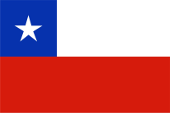 |
National-, Handels- und Marineflagge – national, merchant and naval flag, Seitenverhältnis – ratio = 2:3, Quelle/Source nach/by: Corel Draw 4 |
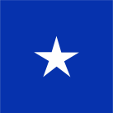 |
Gösch – jack, |
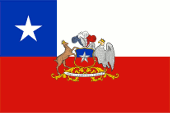 |
Flagge des Präsidenten |
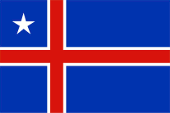 |
Flagge für Gesandte und Divisions Generale |
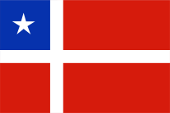 |
Flagge für Geschäftsträger, Provinzintendanten und Brigadegenerale –
flag for Secretaries, Director-Generals of Provinces and Brigade Generals,
Seitenverhältnis – ratio = 2:3, |
historische Flaggen – historical Flags: |
|
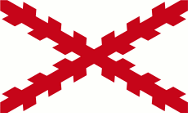 |
1535–1785, Flagge Vizekönigreich Peru und Marine- und Kriegsflagge – Flag of the Viceroyalty of Peru and naval and war flag, Quelle/Source nach/by: Wikipedia (EN) |
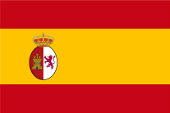 |
1785–1817, Flagge Spaniens und Flagge des Vizekönigreichs Peru – Flag of Spain and of Viceroyalty of Peru Quelle/Source: World Statesmen |
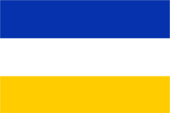 |
1812–1814, Flagge der "Patria Vieja" – flag of the "Patria Vieja", Quelle/Source nach/by: Flags of the World |
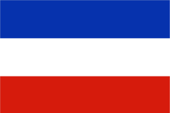 |
1817, Nationalflagge – national flag, Quelle/Source nach/by: Flags of the World |
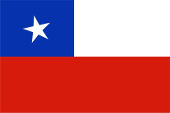 |
1817–1826, National-, Handels- und Marineflagge – national, merchant and naval flag, Seitenverhältnis – ratio = 2:3, Quelle/Source nach/by: Wikipedia (ES) |
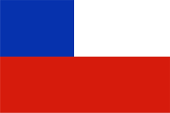 |
1826–1854, National- und Handelsflagge – national and merchant flag, Seitenverhältnis – ratio = 2:3, Quelle/Source nach/by: Wikipedia (ES) |
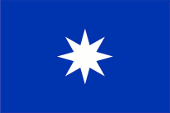 |
18. Jhd./cent., historische Flagge der Araukaner (Mapuche) – historical flag fo the Araucan Nations (Mapuche), Quelle/Source nach/by: Mark Twain: "Reise um die Welt", 1897, Wikipedia (ES) |
regionale Flaggen – regional Flags: |
|
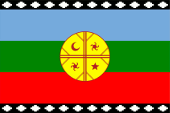 |
Flagge der Mapuche-Indianer – flag fo the Mapuche Indian people, Quelle/Source: Huhsunqu, Public domain, via Wikimedia Commons |
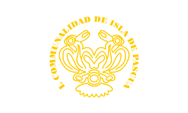 |
Flagge der Osterinsel (←Details, hier klicken) – flag of Easter Island, (←Details, click here) Seitenverhältnis – ratio = 3:5, Quelle/Source: nach/by: World Statesmen |
Bedeutung/Ursprung der Flagge – Meaning/Origin of the Flag: |
|
| Die heutige Flagge von Chile wurde 1854 eingeführt. Sie zeigt zwei waagerechten Streifen in Weiß und Rot, und im weißen Streifen an der Stangenseite ein blaues Quadrat mit einem weißen fünfzackigen Stern. Das Rot steht für das Blut, das zur Erlangung der Unabhängigkeit vergossen wurde, das Weiß für den Schnee auf den Berggipfeln der Anden, und das Blau für den Himmel über Chile. Der weiße Stern wird als Freiheitsstern gedeutet, und steht auch für die Ehre des Landes und den Fortschritt. Die Flagge stellt eine vereinfachte Form des US-amerikanischen Sternenbanners dar, und soll nach ihrer Gestaltung durch den US-amerikanischen Maler Charles Wood vom Kriegsminister Zenteno in Auftrag gegeben worden sein. In der Zeit zwischen 1817 und 1854 war die blaue Oberecke ein Rechteck und kein Quadrat, und der Stern war leicht gedrecht. Für den zivilen Gebrauch gab es zwischen 1826 und 1854 eine zusätzliche Version der Flagge, die nur eine blaue Oberecke ohne Stern zeigte. Als Farben für die Flaggen werden heute angegeben: Rot = pt 485, Blau = pt 286 und Weiß. | The
today's flag of Chile was introduced in 1854. It shows
two horizontal stripes in white and red, and in the white stripe near the
pole a blue square with a white five jagged star. The red stand for the
blood, which was shed for the achievement of the independence, the white for
the snow on the peaks of the Andes, and the blue for the heaven above Chile.
The white star is interpreted as freedom star, and stands for the honor of
the land and the progress, too. The flag pictures a simplifyed form of the US-american "Stars and Stripes", and should, after its designing by the US-american painter Charles Wood, be given in order by the war minister Zenteno. Between 1817 and 1854, the blue top corner was a rectangle, not a square, and the star was slightly rotated. For civil use there was an additional version of the flag between 1826 and 1854, which only showed a plain blue upper corner without a star. The colors given for the flags today are: red = pt 485, blue = pt 286 and white. |
| Die erste chilenische Flagge wurde am 27.10.1812 eingeführt, nachdem die spanische Herrschaft nach Aufständen das erste mal beseitigt worden war. Sie zeigte drei horizontale Streifen in Blau, Weiß und Gelb. Im Jahre 1814 hatte Spanien das Land jedoch wieder unter seiner Kontrolle. Ein zweites mal schüttelte Chile im Jahre 1817 die spanische Herrschaft ab, und es wurde eine neue Flagge eingeführt. Sie zeigte drei horizontale Streifen in Blau, Weiß und Rot, und wurde bis zur Einführung der heutigen Flagge ein Jahr lang beibehalten. | The first
Chilean flag was introduced on 27th of October in 1812, after the Spanish
rule was eliminated after riots for the first time. It showed three
horizontal stripes in blue, white and yellow. In 1814 Spain had the country
but again under its control. A second time Chile shook off the Spanish rule
in 1817, and introduced a new flag. It showed three horizontal stripes in
blue, white and red, and was in use until the introduction of the today's
flag for one year. |
| Quelle/Source: Flaggen Wappen Hymnen, Alle Flaggen alle Staaten, Wikipedia (ES), Flags of the World | |
Wappen – Coat of Arms: |
|
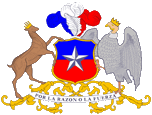 |
Wappen von Chile – coat of arms of Chile, Quelle/Source: Corel Draw 4 |
Bedeutung/Ursprung des Wappens – Meaning/Origin of the Coat of Arms: |
|
| Das Staatswappen wurde 1834 angenommen, und zeigt die Farben der Flagge. Es wurde von Kriegsmister Zenteno entworfen. Unter dem Schild ist ein Spruchband mit dem aus der Zeit der Kämpfe gegen die Spanier stammenden Wahlspruch "Por la Razon o la Fuerza" => "Mit Vernunft oder Gewalt". Schildhalter sind ein Anden-Hirsch (Huemul) und ein Kondor. | The coat of arms was adoped in 1834, and shows the colors of the flag. It was designed by war-minister Zenteno. Below the shield is placed a banner with a saying, from the times of the fight against the Spanish descending motto: "Por la Razon o la Fuerza" => "With reason or violence". Shield holders are a deer of the Andes (Huemul) and a condor. |
| Quelle/Source: Flaggen Wappen Hymnen | |
Flugzeugkokarde – aircraft roundel: |
|
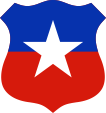 |
Flugzeugkokarde von Chile – aircraft roundel of Chile, Quelle/Source: nach/by Wikipedia (EN) |
 |
Chilen. Flugzeugkokarde für Marineflieger, – Chilean aircraft roundel for Naval Aviation, Quelle/Source: nach/by Wikipedia (EN) |
| Landkarten – Maps: |
Lage – Position: |
Landkarte des Landes – Map of the Country: |
|
|
Zahlen und Fakten – Numbers and Facts: |
|
|
|
|
|
|
|
|
|
|
|
|
|
|
|
|
|
|
|
Geschichte: |
|
13.000 v.Chr.
· erste Besiedlung 1470–1532 · der Norden des heutigen Chile gehört zum Inkareich 1520 · der portugiesische Seefahrer Ferdinand Magellan entdeckt die Magellanstraße im Süden des heutigen Chile 1535–1540 · spanische Eroberung unter Diego de Almagro 1541 · Pedro de Valdivia gründet die Stadt Santiago 1542 · Anschluss des Nordens des heutigen Chile an das Vizekönigreich Peru als Provinz, Araukanien, der heutige Süden, verbleibt unter der Herrschaft der Indianer (Araukaner) 1609 · Chile wird Generalkapitanat innerhalb des Vizekönigreichs Peru 1778 · Chile wird selbständiges Generalkapitanat der Spanischen Krone 1808 · der Bruder von Napoleon Bonaparte, Joseph, besteigt den spanischen Thron 1810 · Chile erklärt dem abgesetzten spanischen König Ferdinand VII. die Treue und proklamiert sich zur autonomen Provinz innerhalb des spanischen Königreichs, wenig später als vollständig unabhängig ("Patria Vieja") 1813–1814 · Spanischer Unabhängigkeitskrieg, Wiederherstellung der rechtmäßigen Monarchie und Versuch der Rückgewinnung von Chile mit militärischen Mitteln 1818 · Antispanische Erhebung, Schlacht von Maipú, Niederlage der Spanier 12.02.1818 · Chile erklärt seine Unabhängigkeit von Spanien 1836–1839 · siegreicher Krieg gegen Bolivien und Peru 1861 · Eroberung Araukaniens 1865–1871 · Spanisch-Südamerikanischer Krieg 1879–1884 · siegreicher Krieg gegen Bolivien und Peru (Salpeterkrieg) => Gebietszuwachs im Norden 1883 · vollständige Annexion Araukaniens 1891 · Bürgerkrieg 1893–1902 · Grenzstreit mit Argentinien 1924–1932 · Diktatur 1934 · Aufstand der Mapuche-Indianer 1944 · Eintritt in den Zweiten Weltkrieg auf der Seite der Alliierten 1945 · Gründungsmitglied der UNO 1948 · Beitritt zur OAS 1970 · Wahlsieg der Unidad Popular (UP), einer Partei mit sozialistischem Programm, Salvador Allende wird Präsident 1973 · Militärputsch unter General Augusto Pinochet 1973–1989 · Pinochet-Diktatur 1978 · Grenzstreit mit Argentinien um die Inseln Lennox, Picton und Nueva, im Beagle-Kanal 1984 · Friedensvertrag zwischen Chile und Argentinien, die Beagle-Kanal-Inseln kommen endgültig an Chile |
History: |
|
13.000 B.C. · First settlement 1470–1532 · the north of today's Chile is part of the Inca Empire 1520 · the Portuguese seafarer Ferdinand Magellan discoveres the Strait of Magellan in today's southern Chile 1535–1540 · Spanish conquest under Diego de Almagro 1541 · Pedro de Valdivia founds Santiago 1542 · annexation of the north of today's Chile to the Viceroyalty of Peru as a province, Araucania – the south of today's Chile – remains under the domination of the Indians (Araucana) 1609 · Chile becomes a captaincy general within the viceroyalty of Peru 1778 · Chile becomes an independently captaincy general under the Spanish crown 1808 · Joseph, the brother of Napoléon Bonaparte, ascends the Spanish throne 1810 · Chile declares loyal to the deposed Spanish King Ferdinand VII. and proclaimes themselves an autonomous province within the Spanish kingdom, and a little later as fully independent ("Patria Vieja") 1813–1814 · Spanish War of Independence, restoring of the the legitim monarchy and attempt to recover Chile by military means 1818 · anti-Spanish revolt, in the Battle of Maipú defeat of the Spanish 12th of February in 1818 · Chile declares its independence from Spain 1836–1839 · victorious war against Bolivia and Peru 1861 · conquest of Araucania 1865–1871 · Spanish-South American War 1879–1884 · victorious war against Bolivia and Peru (Niter War) => win of territorities in the north 1883 · complete annexation of Araucania 1891 · civil war 1893–1902 · border dispute with Argentina 1924–1932 · dictatorship 1934 · uprising of the Mapuche Indians 1944 · entry into the Second World War on the side of the Allies 1945 · founding member of the UN 1948 · accession to the OAS 1970 · electional victory of the Unidad Popular (UP), a party with a socialist program, Salvador Allende becomes president 1973 · military coup, led by General Augusto Pinochet 1973–1989 · Pinochet dictatorship 1978 · border dispute with Argentina about the islands Lennox, Picton and Nueva, in the Beagle Channel 1984 · Peace treaty between Chile and Argentina, the Beagle Channel Islands finally come to Chile |
| Quelle/Source: Wikipedia (D) |
Ursprung des Landesnamens – Origin of the Country's Name: |
|
| Der Name "Chile" stammt aus der Sprache der Aymara, einem Indianerstamm im Norden des Landes. Das Wort bedeutet "Ende des Landes". Eine andere Theorie nennt einen Ursprung in dem Wort "tchili" aus der Inka-Sprache Quechua, was "Schnee" heißt. Beides Hinweise auf die hier herrschenden geographischen Besonderheiten. Der Süden des Landes wurde früher Araukanien genannt. Die Araukaner sind die indianischen Ureinwohner einiger südlichen Regionen Amerikas. Sie gehören verschiedenen Völkern an: Picunche, Mapuche, Huilliche und Pehuenche. | The name
"Chile" comes from the language of the Aymara, an native indian tribe in the
north of the country. The word means "end of the country." Another theory
sees an origin in the word "tchili" out of the Inca language Quechua, what
means: "snow". Both are indications of the prevailing geographic
peculiarities here. The south of the country was formerly called Araucania.
The Araucana are the indigenous natives of some southern regions of America.
They belong to different nations: Picunche, Mapuche, Huilliche and
Pehuenche. |
| Quelle/Source: Handbuch der geographischen Namen, Wikipedia (D), Discovery '97 | |